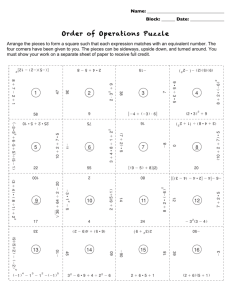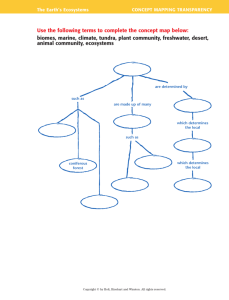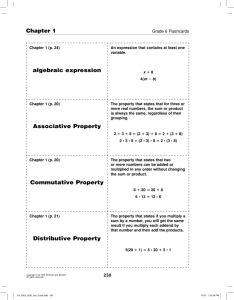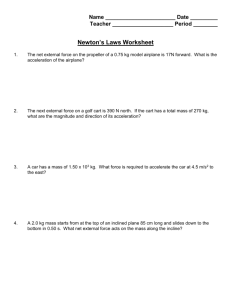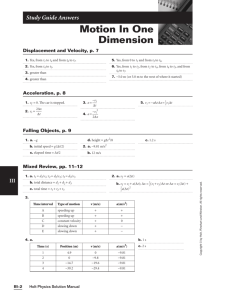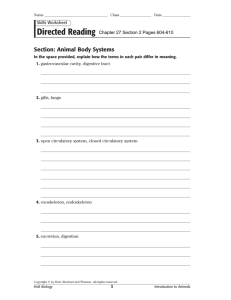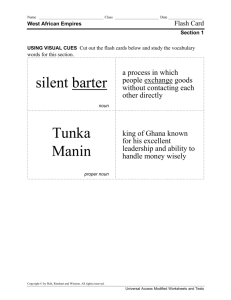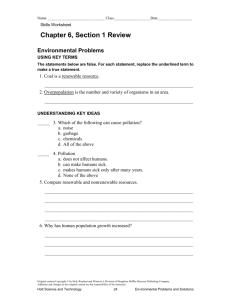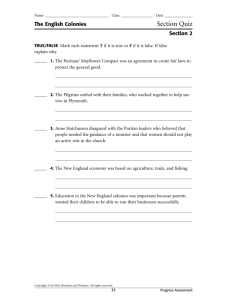Chapter C5
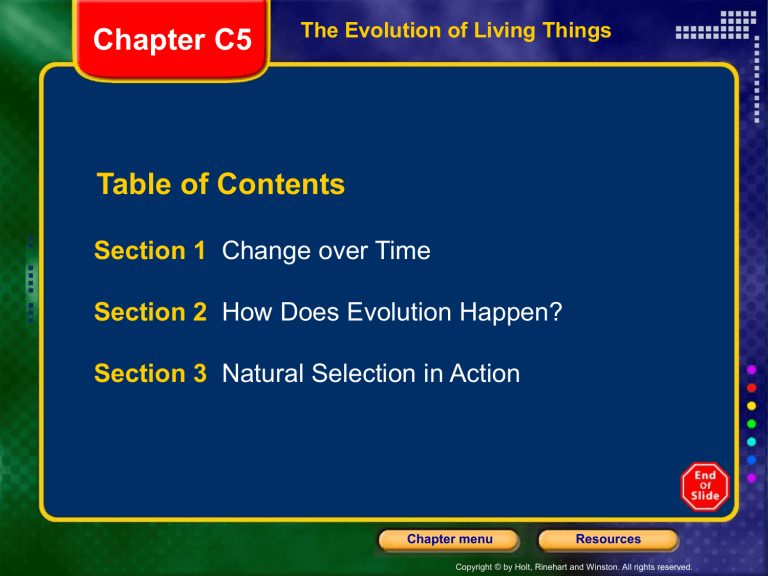
Chapter C5
The Evolution of Living Things
Table of Contents
Section 2 How Does Evolution Happen?
Section 3 Natural Selection in Action
Copyright © by Holt, Rinehart and Winston. All rights reserved.
Chapter C5
Section 1 Change over Time
Bellringer
The cockroach first appeared on Earth over 250 million years ago and is thriving today all over the world. A giant deer that was 2 m tall and had antlers up to 3.6 m wide first appeared less than 1 million years ago and became extinct around
11,000 years ago. Why do you think one animal thrived and the other one perished?
Record your answer in your science journal.
Copyright © by Holt, Rinehart and Winston. All rights reserved.
Chapter C5
Section 1 Change over Time
Objectives
• Identify two kinds of evidence that show that organisms have evolved.
• Describe one pathway through which a modern whale could have evolved from an ancient mammal.
• Explain how comparing organisms can provide evidence that they have ancestors in common.
Copyright © by Holt, Rinehart and Winston. All rights reserved.
Chapter C5
Section 1 Change over Time
Differences Among Organisms
• What Is a Species?
A species is a group of organisms that can mate with one another to produce fertile offspring. A characteristic that helps an organism survive and reproduce in its environment is called an adaptation.
Copyright © by Holt, Rinehart and Winston. All rights reserved.
Chapter C5
Section 1 Change over Time
Differences Among Organisms, continued
• Do Species Change over Time?
Scientists observe that species have changed over time.
The process in which populations gradually change over time is called evolution.
Copyright © by Holt, Rinehart and Winston. All rights reserved.
Chapter C5
Section 1 Change over Time
Evolution
Click below to watch the Visual Concept.
Visual Concept
You may stop the video at any time by pressing the Esc key.
Copyright © by Holt, Rinehart and Winston. All rights reserved.
Chapter C5
Section 1 Change over Time
Evidence of Change over Time
• Fossils The remains or imprints of once-living organisms found in layers of rock called fossils.
• The Fossil Record By studying fossils, scientists have made a timeline of life known as the fossil record. The fossil record organizes fossils by their estimated ages and physical similarities.
Copyright © by Holt, Rinehart and Winston. All rights reserved.
Chapter C5
Section 1 Change over Time
Evidence of Ancestry
• Order of Life The fossil record provides evidence about the order in which species have existed.
• Drawing Connections Scientists have named and described hundreds of thousands of living and ancient species. Scientists use information about these species to sketch out a “ tree of life” that includes all known organisms.
Copyright © by Holt, Rinehart and Winston. All rights reserved.
Chapter C5
Section 1 Change over Time
Examining Organisms
• Case Study: Evolution of the Whale Scientists think that the ancient ancestor of whales was probably a mammal that lived on land and that could run on four legs.
• Walking Whales The organisms shown on the next slide form a sequence between ancient four-legged mammals and modern whales. Several pieces of evidence indicate that these species are related by ancestry.
Copyright © by Holt, Rinehart and Winston. All rights reserved.
Chapter C5
Section 1 Change over Time
Copyright © by Holt, Rinehart and Winston. All rights reserved.
Chapter C5
Section 1 Change over Time
Copyright © by Holt, Rinehart and Winston. All rights reserved.
Chapter C5
Section 1 Change over Time
Comparing Organisms
• Comparing Skeletal Structures The structure and order of bones of a human arm are similar to those of the front limbs of a cat, a dolphin, and a bat.
These similarities suggest that cats, dolphins, bats, and humans had a common ancestor.
Copyright © by Holt, Rinehart and Winston. All rights reserved.
Chapter C5
Section 1 Change over Time
Copyright © by Holt, Rinehart and Winston. All rights reserved.
Chapter C5
Section 1 Change over Time
Comparing Organisms, continued
• Comparing DNA The greater the number of similarities in DNA between species, the more closely those two species are related through a common ancestor.
• The fact that all existing species have DNA supports the theory that all species share a common ancestor.
Copyright © by Holt, Rinehart and Winston. All rights reserved.
Chapter C5
Section 2 How Does Evolution
Happen?
Bellringer
Upright walking, hair, fingerprints, binocular vision, and speech are all traits that almost all humans have in common. List the advantages and disadvantages of each trait. Do you think the advantages are greater than the disadvantages? Why or why not?
Record your responses in your science journal.
Copyright © by Holt, Rinehart and Winston. All rights reserved.
Chapter C5
Section 2 How Does Evolution
Happen?
Objectives
• List four sources of Charles Darwin’s ideas about evolution.
• Describe the four parts of Darwin’s theory of evolution by natural that gradual processes had changed the Earth’s surface over selection.
• Relate genetics to evolution.
Copyright © by Holt, Rinehart and Winston. All rights reserved.
Chapter C5
Section 2 How Does Evolution
Happen?
Charles Darwin
• Darwin’s Excellent Adventure After Charles
Darwin graduated from college, he served as naturalist on a ship called the HMS Beagle . During a voyage around the world, Darwin collected thousands of plant and animal samples.
Copyright © by Holt, Rinehart and Winston. All rights reserved.
Chapter C5
Section 2 How Does Evolution
Happen?
Charles Darwin
• Darwin’s Finches Darwin noticed that the finches of the Galápagos Islands were a little different from the finches in Ecuador. And the finches on each island differed from the finches on the other islands.
Copyright © by Holt, Rinehart and Winston. All rights reserved.
Chapter C5
Section 2 How Does Evolution
Happen?
Darwin’s Thinking
• Ideas About Breeding The process in which humans select which plants or animals to reproduce based on certain desired traits is called selective breeding. (examples: dogs and farm animals)
• Ideas About Population Only a limited number of individuals survive to reproduce. Thus, there is something special about the offspring of the survivors.
Copyright © by Holt, Rinehart and Winston. All rights reserved.
Chapter C5
Section 2 How Does Evolution
Happen?
Darwin’s Thinking, continued
• Ideas About Earth’s History Darwin had begun to think that species could evolve over time. It became clear to Darwin that Earth was much older than anyone had imagined.
Copyright © by Holt, Rinehart and Winston. All rights reserved.
Chapter C5
Section 2 How Does Evolution
Happen?
Darwin’s Theory of Natural Selection
• What Is Natural Selection?
Darwin proposed the theory that evolution happens through a process that he called natural selection.
Individuals that are better adapted to their environment survive and reproduce more successfully than less well adapted individuals.
• Genetics and Evolution Today, scientists have found most of the evidence that Darwin lacked. They know that variation happens as a result of differences in genes.
Copyright © by Holt, Rinehart and Winston. All rights reserved.
Chapter C5
Section 2 How Does Evolution
Happen?
Chapter C5
Section 3 Natural Selection in Action
Bellringer
Write the four parts of natural selection, and create a mnemonic device to remember each part by using the first letter of the words.
Write your response in your science journal.
Copyright © by Holt, Rinehart and Winston. All rights reserved.
Chapter C5
Section 3 Natural Selection in Action
Objectives
• Give three examples of natural selection in action.
• Outline the process of speciation.
Copyright © by Holt, Rinehart and Winston. All rights reserved.
Chapter C5
Section 3 Natural Selection in Action
Changes in Populations
• Adaptation to Hunting People hunt elephants for their tusks. As a result, fewer of the elephants that have tusks survive to reproduce, and more of the tuskless elephants survive.
• Insecticide Resistance A few insects in a population may be naturally resistant to a chemical insecticide. These insects pass their resistance trait to their offspring, and an insect population gradually becomes resistant to the insecticide.
Copyright © by Holt, Rinehart and Winston. All rights reserved.
Chapter C5
Section 3 Natural Selection in Action
Changes in Populations, continued
Copyright © by Holt, Rinehart and Winston. All rights reserved.
Chapter C5
Section 3 Natural Selection in Action
Changes in Populations, continued
• Competition for Mates Many species have so much competition for mates that interesting adaptations result. For example, the females of many bird species prefer to mate with males that have colorful feathers.
Copyright © by Holt, Rinehart and Winston. All rights reserved.
Chapter C5
Section 3 Natural Selection in Action
Forming a New Species
• Sometimes, drastic changes that can form a new species take place. The formation of a new species as a result of evolution is called speciation.
Copyright © by Holt, Rinehart and Winston. All rights reserved.
Chapter C5
Section 3 Natural Selection in Action
Copyright © by Holt, Rinehart and Winston. All rights reserved.
Chapter C5
Section 3 Natural Selection in Action
Forming a New Species, continued
• Separation Speciation often begins when a part of a population becomes separated from the rest.
• Adaptation Populations constantly undergo natural selection. After two groups have separated, natural selection may act on each group in different ways.
Copyright © by Holt, Rinehart and Winston. All rights reserved.
Chapter C5
Section 3 Natural Selection in Action
Forming a New Species, continued
• Division Over many generations, two separated groups of a population may become very different until the point when they can no longer mate with one another. At this point, the two groups are no longer the same species.
Copyright © by Holt, Rinehart and Winston. All rights reserved.
Chapter C5
Section 3 Natural Selection in Action
Species
Click below to watch the Visual Concept.
Visual Concept
You may stop the video at any time by pressing the Esc key.
Copyright © by Holt, Rinehart and Winston. All rights reserved.
Chapter C5
The Evolution of Living Things
Concept Map
Use the terms below to complete the concept map on the next slide.
evolution evidence extinct species living species common ancestors
DNA time fossil record body structures
Copyright © by Holt, Rinehart and Winston. All rights reserved.
Chapter C5
The Evolution of Living Things
Copyright © by Holt, Rinehart and Winston. All rights reserved.
Chapter C5
The Evolution of Living Things
Copyright © by Holt, Rinehart and Winston. All rights reserved.
End of Chapter C5 Show
Copyright © by Holt, Rinehart and Winston. All rights reserved.
Chapter C5
Standardized Test Preparation
Reading
Read each of the passages. Then, answer the questions that follow each passage.
Copyright © by Holt, Rinehart and Winston. All rights reserved.
Chapter C5
Standardized Test Preparation
Passage 1 When the Grand Canyon was forming, a single population of tassel-eared squirrels may have been separated into two groups. Today, descendants of the two groups live on opposite sides of the canyon.
The two groups share many characteristics, but they do not look the same. For example, both groups have tasseled ears, but each group has a unique fur color pattern. An important difference between the groups is that the Abert squirrels live on the south rim of the canyon, and the Kaibab squirrels live on the north rim.
Continued on the next slide
Copyright © by Holt, Rinehart and Winston. All rights reserved.
Chapter C5
Standardized Test Preparation
Passage 1, continued
The environments on the two sides of the Grand
Canyon are different. The north rim is about 370 m higher than the south rim. Almost twice as much precipitation falls on the north rim than on the south rim every year. Over many generations, the two groups of squirrels have adapted to their new environments. Over time, the groups became very different. Many scientists think that the two types of squirrels are no longer the same species. The development of these two squirrel groups is an example of speciation in progress.
Copyright © by Holt, Rinehart and Winston. All rights reserved.
Chapter C5
Standardized Test Preparation
1. Which of the following statements best describes the main idea of this passage?
A Speciation is evident in two groups of squirrels in the
Grand Canyon area.
B Two groups of squirrels in the Grand Canyon area are closely related.
C Two species can form from one species. This process is called speciation.
D There are two groups of squirrels because the Grand
Canyon has two sides.
Copyright © by Holt, Rinehart and Winston. All rights reserved.
Chapter C5
Standardized Test Preparation
1. Which of the following statements best describes the main idea of this passage?
A Speciation is evident in two groups of squirrels in the
Grand Canyon area.
B Two groups of squirrels in the Grand Canyon area are closely related.
C Two species can form from one species. This process is called speciation.
D There are two groups of squirrels because the Grand
Canyon has two sides.
Copyright © by Holt, Rinehart and Winston. All rights reserved.
Chapter C5
Standardized Test Preparation
2. Which of the following statements about the two types of squirrels is true?
F They look the same.
G They live in similar environments.
H They have tasseled ears.
I They can interbreed with each other.
Copyright © by Holt, Rinehart and Winston. All rights reserved.
Chapter C5
Standardized Test Preparation
2. Which of the following statements about the two types of squirrels is true?
F They look the same.
G They live in similar environments.
H They have tasseled ears.
I They can interbreed with each other.
Copyright © by Holt, Rinehart and Winston. All rights reserved.
Chapter C5
Standardized Test Preparation
Passage 2 You know from experience that individuals in a population are not exactly the same. If you look around the room, you will see a lot of differences among your classmates. You may have even noticed that no two dogs or two cats are exactly the same. No two individuals have exactly the same adaptations. For example, one cat may be better at catching mice, and another is better at running away from dogs.
Continued on the next slide
Copyright © by Holt, Rinehart and Winston. All rights reserved.
Chapter C5
Standardized Test Preparation
Passage 2, continued Observations such as these form the basis of the theory of natural selection.
Because adaptations help organisms survive to reproduce, the individuals that are better adapted to their environment are more likely to pass their traits to future generations.
Copyright © by Holt, Rinehart and Winston. All rights reserved.
Chapter C5
Standardized Test Preparation
1. In the passage, what does population mean?
A a school
B some cats and dogs
C a group of the same type of organism
D a group of individuals that are the same
Copyright © by Holt, Rinehart and Winston. All rights reserved.
Chapter C5
Standardized Test Preparation
1. In the passage, what does population mean?
A a school
B some cats and dogs
C a group of the same type of organism
D a group of individuals that are the same
Copyright © by Holt, Rinehart and Winston. All rights reserved.
Chapter C5
Standardized Test Preparation
2. In this passage, which of the following are given as examples of adaptations?
F differences among classmates
G differences among cats
H differences between cats and dogs
I differences among environments
Copyright © by Holt, Rinehart and Winston. All rights reserved.
Chapter C5
Standardized Test Preparation
2. In this passage, which of the following are given as examples of adaptations?
F differences among classmates
G differences among cats
H differences between cats and dogs
I differences among environments
Copyright © by Holt, Rinehart and Winston. All rights reserved.
Chapter C5
Standardized Test Preparation
3. Which of the following statements about the individuals in a population that survive to reproduce is true?
A They have the same adaptations.
B They are likely to pass on adaptations to the next generation.
C They form the basis of the theory of natural selection.
D They are always better hunters.
Copyright © by Holt, Rinehart and Winston. All rights reserved.
Chapter C5
Standardized Test Preparation
3. Which of the following statements about the individuals in a population that survive to reproduce is true?
A They have the same adaptations.
B They are likely to pass on adaptations to the next generation.
C They form the basis of the theory of natural selection.
D They are always better hunters.
Copyright © by Holt, Rinehart and Winston. All rights reserved.
Chapter C5
Standardized Test Preparation
Interpreting Graphics
The graph below shows average beak sizes of a group of finches on one island over several years. Use the graph to answer the questions that follow.
Copyright © by Holt, Rinehart and Winston. All rights reserved.
Chapter C5
Standardized Test Preparation
1. In which of the years studied was average beak size the largest?
A 1977
B 1980
C 1982
D 1984
Copyright © by Holt, Rinehart and Winston. All rights reserved.
Chapter C5
Standardized Test Preparation
1. In which of the years studied was average beak size the largest?
A 1977
B 1980
C 1982
D 1984
Copyright © by Holt, Rinehart and Winston. All rights reserved.
Chapter C5
Standardized Test Preparation
2. If beak size in this group of birds is linked to the amount of rainfall, what can you infer about the year 1976 on this island?
F The year 1976 was drier than
1977.
G The year 1976 was drier than
1980.
H The year 1976 was wetter than 1977.
I The year 1976 was wetter than
1984.
Copyright © by Holt, Rinehart and Winston. All rights reserved.
Chapter C5
Standardized Test Preparation
2. If beak size in this group of birds is linked to the amount of rainfall, what can you infer about the year 1976 on this island?
F The year 1976 was drier than
1977.
G The year 1976 was drier than
1980.
H The year 1976 was wetter than 1977.
I The year 1976 was wetter than
1984.
Copyright © by Holt, Rinehart and Winston. All rights reserved.
Chapter C5
Standardized Test Preparation
3. During which year(s) was rainfall probably the lowest on the island?
A 1978, 1980, and 1982
B 1977, 1980, 1982, and 1984
C 1982
D 1984
Copyright © by Holt, Rinehart and Winston. All rights reserved.
Chapter C5
Standardized Test Preparation
3. During which year(s) was rainfall probably the lowest on the island?
A 1978, 1980, and 1982
B 1977, 1980, 1982, and 1984
C 1982
D 1984
Copyright © by Holt, Rinehart and Winston. All rights reserved.
Chapter C5
Standardized Test Preparation
4. Which of the following statements best summarizes this data?
F Average beak size stayed about the same except during wet years.
G Average beak size decreased during dry years and increased during wet years.
H Average beak size increased during dry years and decreased during wet years.
I Average beak size changed randomly.
Copyright © by Holt, Rinehart and Winston. All rights reserved.
Chapter C5
Standardized Test Preparation
4. Which of the following statements best summarizes this data?
F Average beak size stayed about the same except during wet years.
G Average beak size decreased during dry years and increased during wet years.
H Average beak size increased during dry years and decreased during wet years.
I Average beak size changed randomly.
Copyright © by Holt, Rinehart and Winston. All rights reserved.
Chapter C5
Standardized Test Preparation
Math
Read each question, and choose the best answer.
Average Beak Measurements of Birds of the Colores Islands
Island Ave. beak length (mm)
Ave. beak width (mm)
No. of unique species
Verde
Azul
Rosa
9.7
8.9
5.2
6.5
8.7
8.0
5
15
10
Copyright © by Holt, Rinehart and Winston. All rights reserved.
Chapter C5
Standardized Test Preparation
1. What is the ratio of the number of species on Verde
Island to the total number of species on all three of the
Colores Islands?
A 1:2
B
C
D
1:5
1:6
5:15
Average Beak Measurements of Birds of the Colores Islands
Island Ave. beak length (mm)
Ave. beak width (mm)
No. of unique species
Verde
Azul
Rosa
9.7
8.9
5.2
6.5
8.7
8.0
5
15
10
Copyright © by Holt, Rinehart and Winston. All rights reserved.
Chapter C5
Standardized Test Preparation
1. What is the ratio of the number of species on Verde
Island to the total number of species on all three of the
Colores Islands?
A 1:2
B
C
D
1:5
1:6
5:15
Average Beak Measurements of Birds of the Colores Islands
Island Ave. beak length (mm)
Ave. beak width (mm)
No. of unique species
Verde
Azul
Rosa
9.7
8.9
5.2
6.5
8.7
8.0
5
15
10
Copyright © by Holt, Rinehart and Winston. All rights reserved.
Chapter C5
Standardized Test Preparation
I
2. What percentage of all bird species on the Colores
Islands are on Rosa Island?
F approximately 15%
G approximately 30%
H approximately 50% approximately 80%
Island No. of unique species
Verde
Azul
Rosa
5
15
10
Copyright © by Holt, Rinehart and Winston. All rights reserved.
Chapter C5
Standardized Test Preparation
I
2. What percentage of all bird species on the Colores
Islands are on Rosa Island?
F approximately 15%
G approximately 30%
H approximately 50% approximately 80%
Island No. of unique species
Verde
Azul
Rosa
5
15
10
Copyright © by Holt, Rinehart and Winston. All rights reserved.
Chapter C5
Standardized Test Preparation
3. On which of the islands is the ratio of average beak length to average beak width closest to 1:1?
A Verde Island
B Azul Island
Island Ave. beak length (mm)
Verde
C Rosa Island
Azul
D There is not enough information to determine the answer.
Rosa
9.7
8.9
5.2
Ave. beak width (mm)
6.5
8.7
8.0
Copyright © by Holt, Rinehart and Winston. All rights reserved.
Chapter C5
Standardized Test Preparation
3. On which of the islands is the ratio of average beak length to average beak width closest to 1:1?
A Verde Island
B Azul Island
Island Ave. beak length (mm)
Verde
C Rosa Island
Azul
D There is not enough information to determine the answer.
Rosa
9.7
8.9
5.2
Ave. beak width (mm)
6.5
8.7
8.0
Copyright © by Holt, Rinehart and Winston. All rights reserved.
Chapter C5
Standardized Test Preparation
4. On which island does the bird with the smallest beak length live?
F Verde Island
G
H
Azul Island
Rosa Island
I There is not enough information to determine the answer.
Island Ave. beak length (mm)
Verde
Azul
Rosa
9.7
8.9
5.2
Ave. beak width (mm)
6.5
8.7
8.0
Copyright © by Holt, Rinehart and Winston. All rights reserved.
Chapter C5
Standardized Test Preparation
4. On which island does the bird with the smallest beak length live?
F Verde Island
G
H
Azul Island
Rosa Island
I There is not enough information to determine the answer.
Island Ave. beak length (mm)
Verde
Azul
Rosa
9.7
8.9
5.2
Ave. beak width (mm)
6.5
8.7
8.0
Copyright © by Holt, Rinehart and Winston. All rights reserved.
Chapter C5
Section 1 Change over Time
Copyright © by Holt, Rinehart and Winston. All rights reserved.
Chapter C5
Section 2 How Does Evolution
Happen?
Copyright © by Holt, Rinehart and Winston. All rights reserved.
Chapter C5
Section 2 How Does Evolution
Happen?
Copyright © by Holt, Rinehart and Winston. All rights reserved.
Chapter C5
Section 3 Natural Selection in Action
Copyright © by Holt, Rinehart and Winston. All rights reserved.
Chapter C5
Section 3 Natural Selection in Action
Copyright © by Holt, Rinehart and Winston. All rights reserved.
Chapter C5
Standardized Test Preparation
Copyright © by Holt, Rinehart and Winston. All rights reserved.
